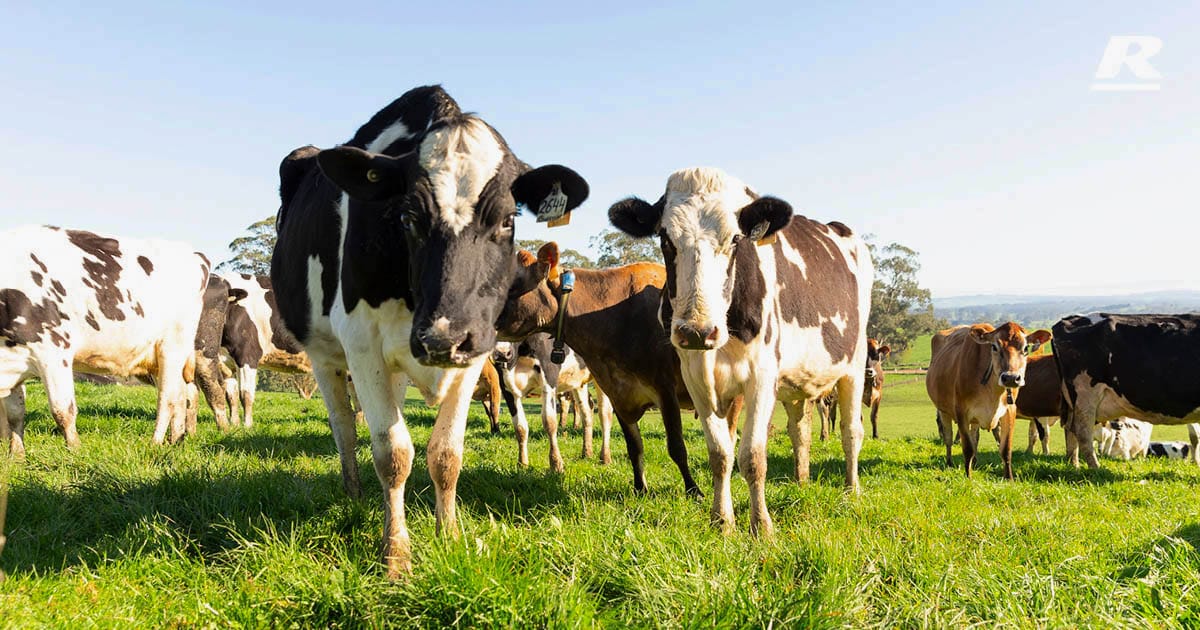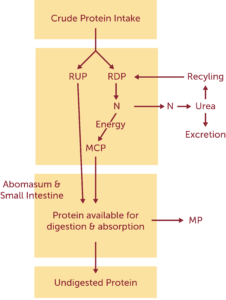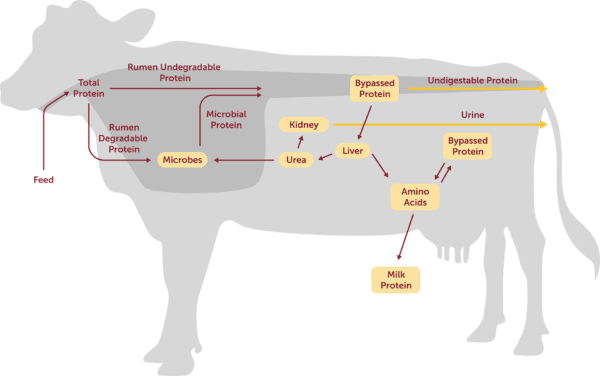The Vital Role of Protein
Protein is the material that is used to build and repair the body’s enzymes, hormones and all tissues (e.g. skin, muscle, organs, and foetus), excluding bone and fat. It is a vital nutrient required for basic metabolic processes, growth, and pregnancy, and is also essential for milk production. Protein sources are used to supply rumen microbes with nitrogen and amino acids for their growth. If there is inadequate total protein in the diet, microbial activity in the rumen decreases which results in a slower rate of digestion. Decreased digestion means less nutrients for absorption by the animal.
Pastures in Victoria provide high quality feed for grazing while they are actively growing but as they mature and move into the reproductive phase, their feed value declines. During the growing phase, the protein content of the pasture is sufficient to maintain a healthy microbe population, however, once the pasture becomes more mature, they become more fibrous and difficult to digest, and as a result, the nutrients become less accessible. At this time, we can supplement additional protein into the diet to improve rate of digestion, which can increase the amount of pasture consumed and therefore improve animal performance.
True protein sources contain amino acids. Amino acids are the building blocks for processes such as the production of protein for milk, tissue growth and the development of the foetus during pregnancy. Cows require 25 different amino acids, of which 15 can be created by the cows’ own metabolism. The remaining 10 are known as ‘essential amino acids’ as they must be either supplied in the diet as dietary protein, or as a result of digestion of the microbes in the rumen known as microbial protein. These microbes are continually flushed from the rumen where they die and are absorbed. When the microbial protein is digested, amino acids are produced which are absorbed through the small intestine.
Crude Protein
Crude protein is the common term used for dietary protein or the amount of protein in a feed source. It is calculated from the total amount of nitrogen within that feed. Some of the nitrogen is in the form of ‘true protein’, while other nitrogen sources are known as non-protein nitrogen (NPN).
Some rumen microbes have the ability to convert NPN into true protein if adequate dietary energy is available. Other microbes require amino acids for their growth and reproduction.
True Dietary Protein
Rumen Degradable Protein (RDP)
Rumen degradable protein is any protein in the diet that is digested and utilised by rumen microbes. Microbes break down the RDP using energy into amino acids, and then to ammonia which is a major source of nitrogen for microbial growth.
Undegradable Dietary Protein (UDP)
This is also known as ‘bypass protein’ which is digested further along the gastrointestinal tract. When intake is greater and rate of passage is quicker, more protein becomes UDP because is moves quickly through the rumen before microbial breakdown has a chance to occur. UDP is an important source of protein as it provides a greater diversity of amino acids than protein that is broken down in the rumen, which is limited to those proteins and their component of amino acids.
The degradability of protein in the diet is affected by factors including dry matter intake, rate of passage (how long feed remains in the rumen), processing, total protein intake and the amount of energy available to the rumen microbes.
Non-protein Nitrogen (NPN)
Non-protein nitrogen is actually simple nitrogen, not protein. Rumen microbes use dietary energy from carbohydrate rich foods to convert NPN to ammonia for microbial protein synthesis, however, this is only done so at 80% efficiency compared to true protein. Urea is an example of NPN.
MCP = Microbial crude protein
MP = Metabolisable protein
How can Reids help you with effective fibre?
- The team at Reid Stockfeeds can assist in creating a balanced diet to ensure that your herd’s protein requirements are satisfactorily met. As this is different for everyone based on each individual farm and herd requirements, your trusted advisor can provide specific advice tailored to you.
- Reid Stockfeeds can also provide feed tests to measure nutrient levels of home grown or bought in feed to accurately determine diet requirements.
To find out more about the best animal feed or health management strategy for your herd, give us a call and have a chat to one of our nutritionist on 1300 REID FEED or enquire here >
 Author
Author
Christine Harris
Sales & Nutrition Account Manager



 Author
Author